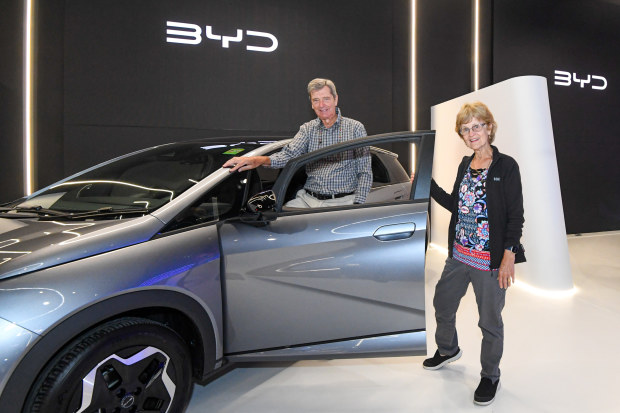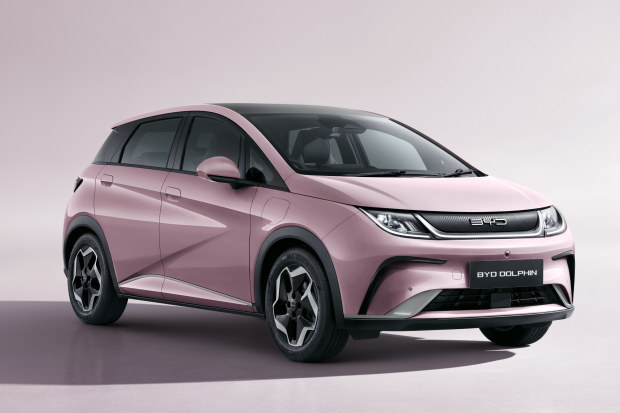Why Chinese EVs are storming Australia

The Australian new car market is rapidly turning Chinese – and the trend is likely to accelerate.
Chinese-built cars already account for 16 per cent of all new cars sold in Australia (third behind Japan and Thailand), but in the battery electric vehicle category – which is to say, the future – they completely dominate.
Just over 86 per cent of Australia’s BEVs are sourced from China, including all our Teslas and Polestars, all electric Volvos and some BMWs.

Don and Joye Walsh bought a BYD because it was much cheaper than a Tesla, and have no regrets. Peter Rae
Overall, Chinese brand BYD sits in second place behind Tesla in the EV sales charts, with the impact of its first sub-$40,000 model, the Dolphin EV, still to be felt. Erstwhile Brit MG – now part of Shanghai-headquartered SAIC Motor – is in third, again with sales of its cheapest offering, the $38,990 MG4, only just starting. Polestar and Volvo are also Chinese-owned, as is Lotus, which is about to put a $239,000 Wuhan-made electric SUV on sale here.
Chinese sales are being propelled by excess domestic factory capacity, leading to superior availability – or, as the Europeans argue, dumping – when other countries are still struggling with supply chain issues. And legacy players are increasingly abandoning the bottom end of the market, allowing the Chinese to win first-time buyers with petrol cars, putting them in the box seat when those customers transition to electricity.
The quality of the products may be slightly uneven but it is rapidly improving, while the range of models (and brands) is expanding. The Chinese cars sold here generally offer good value for money, high equipment levels and generous warranty support. And their once-anonymous designs are starting to show flair.
It’s no longer just copycat cars, either. China is the world’s biggest EV producer, spurred on by a highly competitive domestic market, and that’s bringing innovation. Some Chinese EVs have superior battery technology to foreign rivals. Tesla is now using BYD batteries in its German-produced cars.
Sydneysiders Don and Joye Walsh took delivery of their first BYD car – the ATTO 3 – last month and are already looking to buy a second from China.
Mr Walsh has been a fan of Tesla for years, but said he could not go past the better price of the ATTO 3 when finally making the purchase.
“It was a matter of price – the features [of the ATTO 3] trail a little bit behind the Tesla but the price is materially less. We also believe we paid no more for it than we would have for a similar featured petrol car ... we got a very good car for a very good price.”
Going EV in the first place was also an economic decision. As the price of solar panels and then batteries came down, the couple had spare power coming from their rooftop and saw the opportunity to save money as petrol prices soared.
“It just makes so much sense when petrol prices are going in one direction and the price is going in the other,” Mr Walsh said.
Mrs Walsh was also thrilled with the purchase, and is looking to China for her next car when her current 11-year-old vehicle needs replacing.
Citing the environmental benefits of EVs and a desire to swap to an SUV for ease of getting in and out of the driver’s seat as she gets older, she has her eye on the BYD Dolphin.
Mrs Walsh said environmental concerns played into their decision to buy an EV, but the decision to get a Chinese-manufactured one was purely driven by price.
Market improvements
Chery, a Chinese state-owned car maker, had an unsuccessful foray on this market more than a decade ago, but is now back. It sells the sharply priced Omodo 5 petrol-powered SUV, but promises EVs soon. A string of other Chinese makers will introduce new EV passenger cars next year.
GWM – formerly Great Wall Motor – recently put the cutely styled Ora sedan on sale, completing the trio of sub-$40,000 Chinese EVs. In contrast, the cheapest European EV on sale is the Cupra Born, at just under $60,000.

The BYD Dolphin will be the next Chinese EV under $40,000 to arrive in Australia.
As if to illustrate Europe’s inertia here in the affordable EV market, VW has had a Golf-sized hatchback (the ID.3) on sale overseas since 2019. It still isn’t available in Australia, and in the interim, MG has launched the MG4. This is roughly the same size, vastly cheaper than the projected price of the ID.3, and backed by a seven-year warranty. Most importantly, it is well-built and fun to drive.
VW Australia promises the ID.3 will finally arrive next year, along with other EVs, but it’s easy to see a sales gap opening up that will be hard to narrow. Furthermore, inflation has seen the cheapest Golf in Australia, a 1.4-litre petrol car, rise to $36,290 plus on-road costs. The MG4 EV starts at only $2700 more.
The case against Chinese makers? Their quality and technology isn’t yet Japanese, Korean or European standard, resale is a question mark and, although they are passing safety tests, that isn’t always the same as being safe. Time will tell on that one.
Some would-be buyers point to fears about modern slavery and environmental havoc in the supply chain – and that is a real risk. Then again, when it comes to doing the right thing, consumers might have once trusted a European company ahead of a state-owned (or state-answerable) Chinese one. VW’s Dieselgate debacle has muddied that water.
– with Hannah Wootton
Introducing your Newsfeed
Follow the topics, people and companies that matter to you.
Find out moreRead More
Latest In Cars, bikes, boats
Fetching latest articles